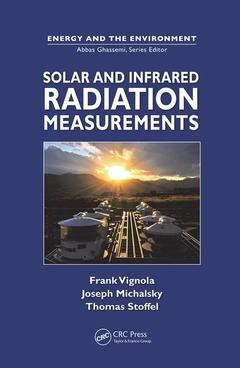Solar and Infrared Radiation Measurements Energy and the Environment Series
Auteurs : Vignola Frank, Michalsky Joseph, Stoffel Thomas

The rather specialized field of solar and infrared radiation measurement has become more and more important in the face of growing demands by the renewable energy and climate change research communities for data that are more accurate and have increased temporal and spatial resolution. Updating decades of acquired knowledge in the field, Solar and Infrared Radiation Measurementsdetails the strengths and weaknesses of instruments used to conduct such solar and infrared radiation measurements.
Topics covered include:
- Radiometer design and performance
- Equipment calibration, installation, operation, and maintenance
- Data quality assessment
- Methods to use measured data to estimate irradiance for any surface
With a broad range of content that will benefit students and more experienced readers alike, this resource serves as a primer and technical reference that presents the basic terminology and fundamentals for resource assessment. It explores the history of solar radiation instruments and addresses direct normal, global, diffuse, and tilted measurements, as well as the characteristics of instruments used for these measurements. The authors consider methods of assessing the uncertainty of solar measurements and then cover albedo, infrared, net, and spectral irradiance measurements and instrumentation. The book devotes a section to other meteorological instruments, and another to the basics for installing and operating a solar monitoring station. Appendices include information on solar resource assessment modeling and satellite-derived irradiance, along with other useful material.
This book?s authors are experts who each have more than 30 years of experience developing and operating multiple measurement stations, working with industry to improve radiometry, and conducting various research projects.
Diffuse Irradiance. Rotating Shadowband Radiometers. Measuring Solar Radiation on a Tilted Surface. Albedo. Infrared Measurements. Net Radiation Measurements. Solar Spectral Measurements. Meteorological Measurements. Setting Up a Solar Monitoring Station. Appendices.
Frank Vignola is the director of the University of Oregon (UO) Solar Energy Center. He received his B.A. in physics at the University of California–Berkeley in 1967 and his Ph.D. in elementary particle physics at the UO in 1975. Deciding to apply his skills to more practical applications he started working in solar energy at the UO in 1977. Vignola helped establish and manage the UO solar radiation monitoring network that has the longest-running high-quality solar radiation data set in the United States. He has organized a number of solar resource assessment workshops and has written and contributed to approximately 100 papers in the field. He is currently an associate editor for solar resource assessment for the Solar Energy Journal.
Joseph Michalsky is a physical scientist in the Earth System Research Laboratory within the National Oceanic and Atmospheric Administration (NOAA). Prior to NOAA he was with the Atmospheric Sciences Research Center at the State University of New York–Albany. He began his career at the Department of Energy’s Pacific Northwest National Laboratory. Michalsky received his B.S. in physics at Lamar University and M.S. and Ph.D. in physics at the University of Kentucky. His early career focused on astronomical research before taking on problems in solar energy and the atmospheric sciences. Michalsky has nearly 100 refereed publications in these fields.
Thomas Stoffel manages the Solar Resources and Forecasting Group at the National Renewable Energy Laboratory. He received his B.S. in aerospace engineering from the University of Colorado and M.S. in meteorology from the University of Utah. He began his career as an aerospace engineer at the U.S. Air Force Propulsion Laboratory simulating gas turbine engine performance and infrared radiation signatures. In 1978, Stoffel joined the Solar Energy Research Institute (now NREL), where he developed the Solar Radiation Research Laboratory (SRRL) that continues to provide researc
Date de parution : 10-2017
15.6x23.4 cm
Disponible chez l'éditeur (délai d'approvisionnement : 14 jours).
Prix indicatif 66,20 €
Ajouter au panierThèmes de Solar and Infrared Radiation Measurements :
Mots-clés :
Aerosol Optical Depth; DNI; Measuring Solar and Infrared Radiation; Solar Zenith Angle; Direct Normal Irradiance; Langley Plots; Measuring Global Irradiance; Thermal Offset; Rotating Shadowband Radiometers; DHI; Infrared Measurements; Ghi; Irradiance Measurements; Diffuse Irradiance; Extraterrestrial Solar Spectrum; Eppley Laboratory; Sun Path Charts; Large Solar Zenith Angles; Cosine Response; Solar Irradiance; Cavity Radiometer; Standard Uncertainty; Local Standard Time; Solar Radiation Measurements; Solar Noon; Large Solar Zenith; Thermopile Detector; Infrared Radiation Measurements; Beam Irradiance; Net Radiometer



